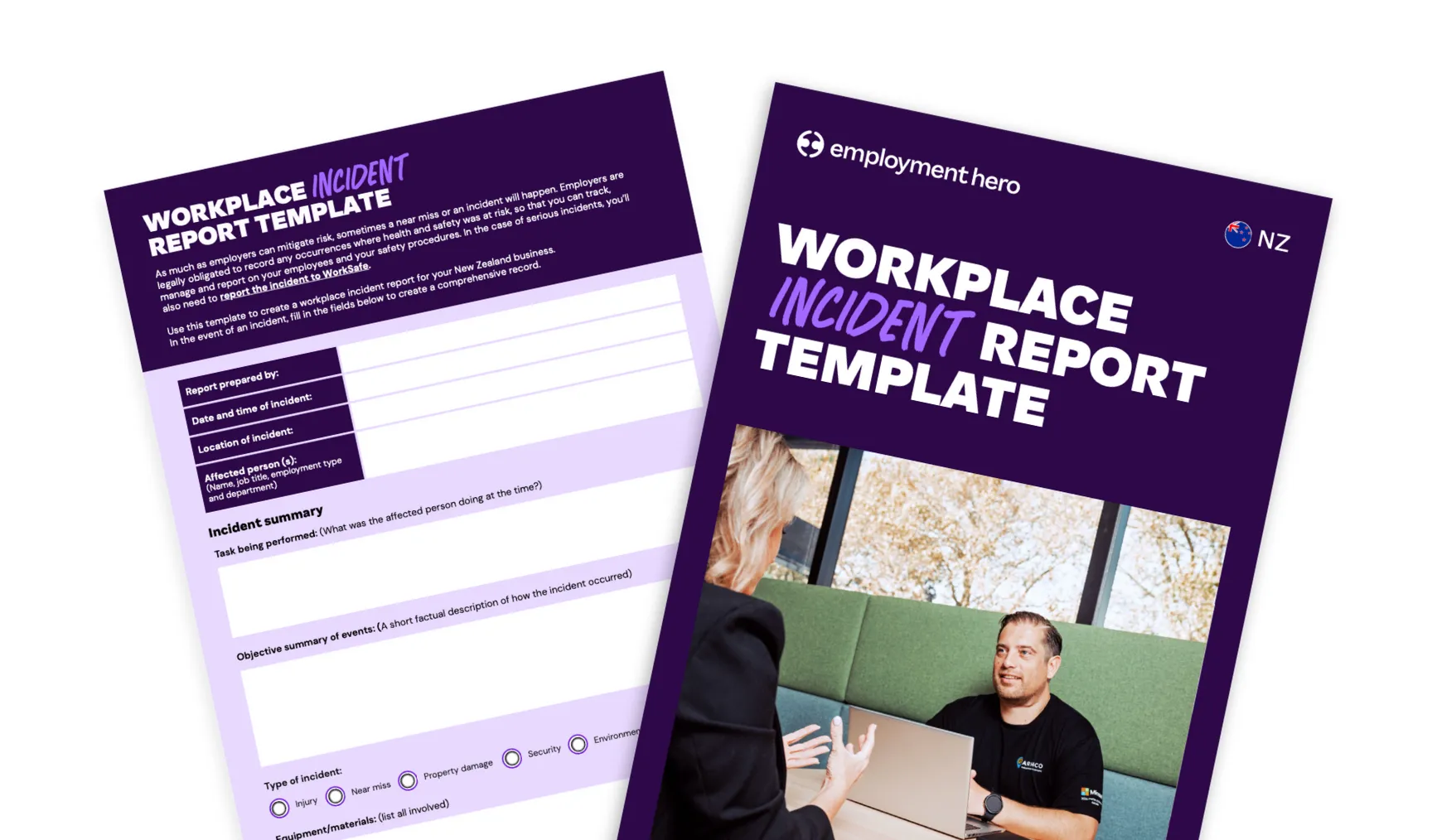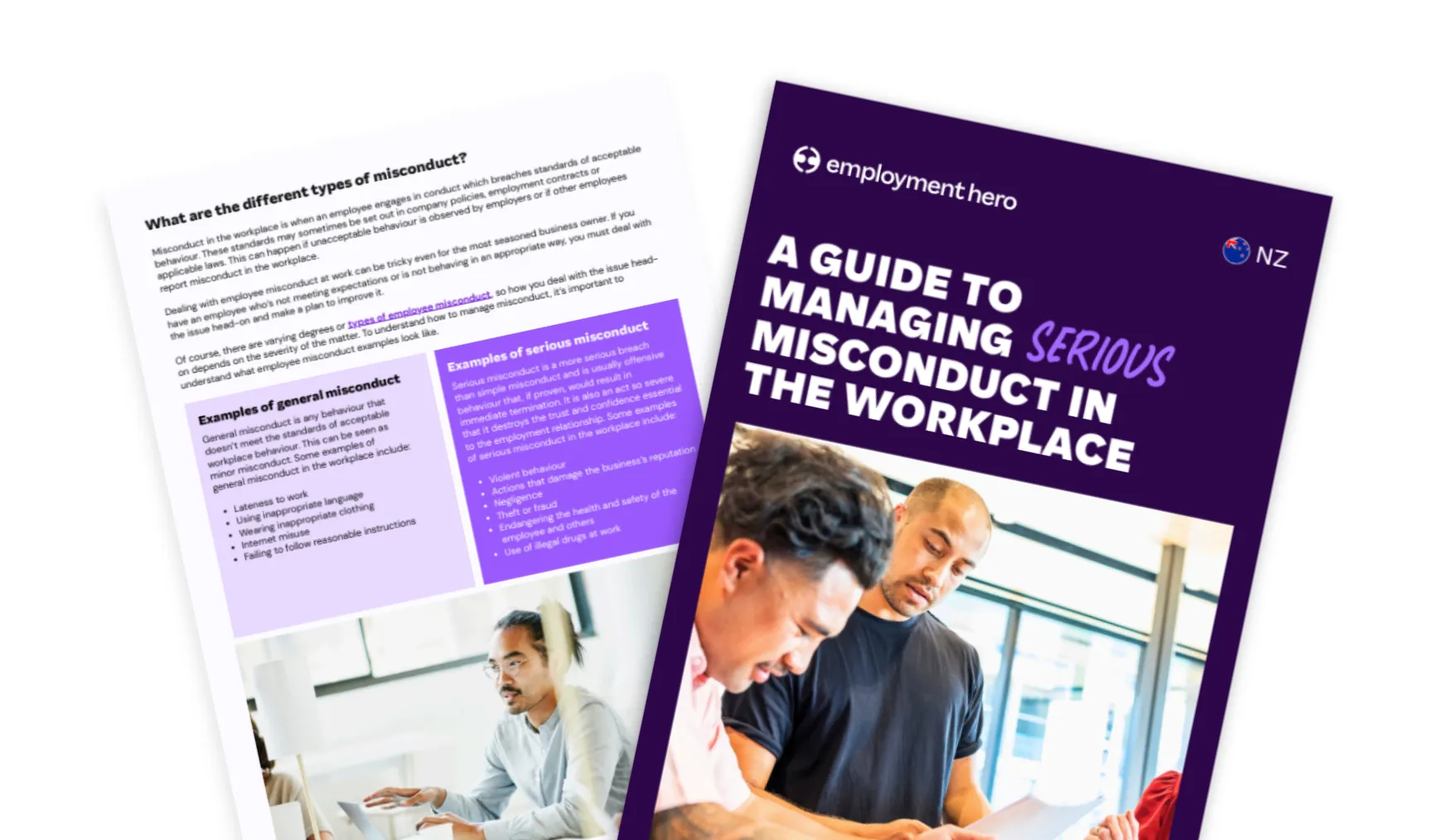Workplace Health and Safety (WHS) policy template and guide
Published
Workplace Health and Safety (WHS) policy template and guide
As a business, you have obligations and responsibilities to keep your team safe and healthy whileAs a business, you have obligations and responsibilities to keep your team safe and healthy while they’re in the workplace. This means that as much as reasonably practicable, you need to make sure people are not put at risk while working.
That’s why building a workplace health and safety policy is crucial for your business.
Ensure your organisation is covered by implementing WHS procedures and policies.
Download our policy template by filling in the form on the right.
About this workplace health and safety policy template
This free New Zealand workplace health & safety (WHS) policy template will outline your organisation’s WHS policies to help prevent your organisation from compliance and liability issues.
The goals of introducing a WHS policy is to:
- Achieve a safe and incident-free workplace
- Consider WHS in project planning and work activities
- Involve workers and subcontractors in the decision-making process through regular communication and consultation
- Ensure workers and subcontractors identify and control risks in the workplace
- Monitor and review the elimination or control of potential risks
- Enhance workers’ WHS knowledge through a program of education and training
You can tailor this WHS policy template to your specific industry, work environment and business size. However, it’s important to seek professional or legal advice to ensure your policy meets your legislative obligations. If you need help, chat to our experts.
What is a workplace health and safety policy?
The aim of having a WHS policy in place is to reduce risks and hazards in the workplace and to ensure the safety of employees. It is usually a document containing safety checklists that businesses have readily available to their teams.
The Health and Safety at Work Act 2015 sets out clear duties for Persons Conducting a Business or Undertaking (PCBUs). A WHS policy helps businesses meet their general duty of care.
Who does the WHS policy apply to?
Your WHS policy should clearly state who it covers. This usually includes:
- Employers
- Employees (full-time, part-time and casual)
- Contractors and subcontractors
- Labour hire workers
- Apprentices and trainees
- Volunteers and work experience students
- Visitors to the workplace
Roles and responsibilities
Clearly define who is responsible for what in maintaining WHS. This might include:
- The business owner or PCBU ensuring compliance and risk mitigation
- Managers and supervisors implementing WHS practices daily
- Workers following procedures, reporting risks and participating in consultations
- Health and Safety Representatives (HSRs), if elected, acting as liaisons
How to build a Workplace Health and Safety policy
Luckily for you, supporting business compliance is what Employment Hero does best! Our employee management tool has many policy templates readily available for your business to use. Find out more by reaching out to our business specialists today.
When putting together a workplace health and safety policy, you need to consider the following things:
Assess potential risks and hazards
Even if you work in an office, there are still things that can go wrong. You need to think through all the hazards and what the potential consequences could be. You should also consider the seriousness of the consequences and the likelihood of this scenario playing out.
For example in the hospitality business, accidents in the workplace such as cuts and burns will occur a lot more regularly. In construction, you have a lot of people working with very heavy tools and dangerous equipment on-site which could cause heaps of health and safety risks if not used correctly.
Every hazard should be recorded but you should give added weight to the ones causing the most risk.
Provide training and resources
Once you’ve identified the risks, you need to think about what you can reasonably do to prevent them from happening and then make those changes inside your business.
It might be introducing additional training, advice or resources related to WHS, or putting up signs to constantly remind people to be vigilant. Whatever it takes, keep trialling new methods to make sure your employees are safe at work.
Collect feedback from employees
Talking to your staff and asking for feedback on what they perceive as a safety risk is a really good opportunity to understand your business better.
Encourage staff members to share their suggestions and brainstorm about how you can create a better working environment. You’ll also have people buy into your WHS policy before you even start.
Your WHS policy should outline how workers can participate in consultation, such as through toolbox talks, health and safety committees or feedback forms.
Set procedures for consultation and communication
Consultation is a requirement according to WorkSafe guidelines. Outline how your business will consult workers on safety matters, changes to procedures or new risks introduced into the workplace. Include how you’ll communicate updates (e.g. email, team meetings, noticeboards).
Document control and record keeping
Your WHS policy should detail how you’ll manage records, including incident reports, training records, consultation notes, risk assessments and audits. This supports legal compliance and helps improve safety over time.
How do you manage a WHS incident?
Despite your best efforts, accidents can and do still happen. With that in mind, you should also include in your health and safety policy what to do if there is an incident or accident at work.
This will ensure if the worst case does arise, everyone is prepared on what to do.
You will need to specify:
- What immediate actions should take place;
- Who in the business needs to be notified and when;
- If/when you need to notify WorkSafe (if appropriate).
You should also have a process on how employees can record incidents, and you should regularly review these events to make sure the workplace remains safe.
Mental health in the workplace
Your business also has an obligation to take care of psychosocial risks in the workplace, which includes the mental health of your staff as far as practically possible. This means preventing bullying, harassment and discrimination in the workplace.
We would recommend sending a clear message that these behaviours won’t be tolerated in the workplace by having separate policies to deal with bullying, harassment and discrimination.
Another good way to care for mental health in the workplace is to introduce an Employee Assistance Program (EAP), so employees can get support if they need it.
Review your WHS policy regularly
Now, once you’ve got this workplace health and safety policy in place, make sure you review it regularly.
Workplace health and safety isn’t a set-and-forget activity. You should continuously be reassessing the risks that are involved in your business and coming up with new strategies to help make the workplace as safe as possible.
How Employment Hero can help
Employment Hero’s Employment Operating System gives you everything you need to manage HR, payroll and people. You also get access to an entire policy library, including templates for workplace health and safety policies. Our policies are constantly reviewed by our employment specialists, so you can be confident your company is up to date with any legislation changes.
Find out more about the Employment Operating System today.
The information in this factsheet is current as at 2 September 2025, and has been prepared by Employment Hero Pty Ltd (ABN 11 160 047 709) and its related bodies corporate (Employment Hero). The views expressed in this factsheet are general information only, are provided in good faith to assist employers and their employees, and should not be relied on as professional advice. Some information is based on data supplied by third parties. While such data is believed to be accurate, it has not been independently verified and no warranties are given that it is complete, accurate, up to date or fit for the purpose for which it is required. Employment Hero does not accept responsibility for any inaccuracy in such data and is not liable for any loss or damages arising directly or indirectly as a result of reliance on, use of or inability to use any information provided in this factsheet. You should undertake your own research and seek professional advice before making any decisions or relying on the information in this factsheet.
To download the policy template, we just need a few quick details.
Related Resources
-
 Read more: Incident report template NZ: free download for businesses
Read more: Incident report template NZ: free download for businessesIncident report template NZ: free download for businesses
Download our free NZ incident report template. Record and report workplace incidents correctly under HSWA and ACC requirements.
-
 Read more: Serious misconduct in New Zealand: What employers must know
Read more: Serious misconduct in New Zealand: What employers must knowSerious misconduct in New Zealand: What employers must know
Learn what serious misconduct means under NZ law, common examples, and how to manage the process legally and fairly. Protect…
-
 Read more: Free business plan template for New Zealand business owners
Read more: Free business plan template for New Zealand business ownersFree business plan template for New Zealand business owners
Published Published Starting and running a business is a journey that needs direction. That’s why a well-crafted business plan is…





















